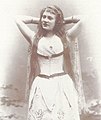Waist cincher

A waist cincher (sometimes referred to as a Waspie) is a belt worn around the waist to make the wearer's waist physically smaller, or to create the illusion of being smaller.
Today
Waist cinchers and Waspies from the 1980s are a type of wide, laced belts with elastic fabric and soft plastic stiffeners.[1]
New Look
Note: In 1950s was waist cincher, Waspie and guêpière was variations and synonyms of girdles and corselets. See: Christian Dior's 'New Look'.[2]
Ribbon corset
The ribbon corset is made of pieces of ribbon, as opposed to fabric. In 1901, a simple pattern of silk ribbon, two bones, and a busk was available, allowing women to construct their own ribbon corsets.[3]
A pseudo-ribbon corset looks like a ribbon corset but is made from cut cloth instead of ribbons. The outside seam of the cut cloth is sewn fine, while the tight inside seam is sewn plain and curved.[4]
Function

A type of short corset been used as light corset for sleep, and another type for light summer corset, used next to the skin or outside of the summer dress. But also an elastic girdle belt been used on the outside of corseted dresses.
The New Look
Dior's New Look brought the waist cincher to popularity around 1947. In his autobiography, Dior wrote: "I designed clothes for flower-like women, with rounded shoulders, full feminine busts, and hand-span waists above enoumous spreading skirts". [5] The hand-span waists beloved by Dior were achieved by foundations garments, of which the most popular was the waist cincher. Called the "waspie" or "guepiere", it became the quintessential undergarment of the New Look. Boned and back-laced, it differed from the Victorian corset of decades past primarily in its length, usually only 6 to 7 inches. Fashion magazines of the time stressed that it was "super-light weight" and containing "feather boning". Such garments were worn tightly cinched at the waist, usually over a girdle. The combination was described by Anne Forgarty, an American dress designer who popularized the New Look in the US [6] "To maintain your figure at its flattering best, depend on foundation garments to control and distribute; a cinch or tight belt to restrain."
Examples and similar corsets and belts
-
Bodice Belt
(1893) -
Straight-front short corset of ribbon, named Ribbon corset, in 1954.[7]
(invisible underwear 1901-1908) -
Lady's belt,something between belt and waist cincher
(visible 1902) -
A Waist Cincher for rest.
(invisible underwear c. 1905) -
A Waist Cincher for a singers costume.
(visible roughly 1905) -
Belt Corset
(invisible underwear 1920) -
Belt Corset
(invisible underwear 1920) -
Inner Belt in corset, invisible underwear, but the same principal as a Waist cincher
(1890)
References
- ^ The Encyclopaedia of Fashion of Georgina O'Hara, 1986.
- ^ The Encyclopaedia of Fashion of Georgina O'Hara, 1986.
- ^ The Delineator; VOL. LVIII. No. 2 August, 1901; page 198-199. (pattern No. 4300)
- ^ CORSET and CRINOLINES by Norah Waugh; page 88
- ^ "Dior by Dior, the Autobiography of Christian Dior, 1957, pp 22f.
- ^ "Wife Dressing", Ann Fortarty, 1959, pp 155f.
- ^ CORSET and CRINOLINES by Norah Waugh; page 88 and 107


![Straight-front short corset of ribbon, named Ribbon corset, in 1954.[7] (invisible underwear 1901-1908)](http://upload.wikimedia.org/wikipedia/commons/thumb/9/9e/THE_DELINEATORaugust1901p199.gif/51px-THE_DELINEATORaugust1901p199.gif)






